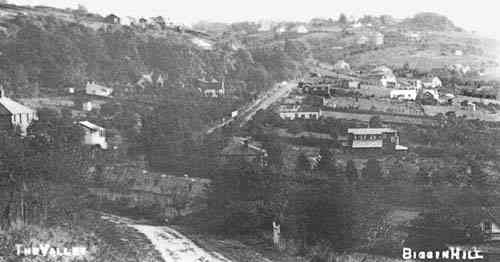Biggin Hill History – Background
It was not until about ninety years ago that Biggin Hill was known as Biggin Hill. Before this time the area was agricultural with farms scattered across the land and was in the Parish of Cudham. There was the Manor of Aperfield which was given to Bishop Odo of Bayeux from William the conqueror. They were half brothers and the Manor was given as a thank you for his support during the battle of Hastings in 1066.
The Manor changed ownership many times and at the end of the seventeenth century was owned by Thomas Lord Dacre, Earl of Sussex. It was he who leased a large part of it to a widow Ann Brasier and in 1699 a survey on the leased land was carried out. a plan was prepared and the outline looks like Biggin Hill as it appears on maps today.
In 1835 the Manor was sold to John Christy of Hatcham Manor in New Cross and the Christy family owned it for sixty years. Some land was used for livestock and arable farming.
Aperfield Manor was sold by auction in 1895 to Frederick Henry Dougal from Wandsworth. Dougal then sold the land cheaply by splitting it in to small parts. A plan was drawn and the plots numbered, but there was no real planning as it would be recognised today. As there were no building regulations at the turn of the century, the land could be used for any purpose.
Existing roads were left as they were, such as Main Road, Stock Hill, Polesteeple Hill, Norheads lane and Oaklands Lane. Hedges and fences were used as the natural courses for new roads and Chestnut, Lime and Poplar trees were planted to provide some protection for the pedestrians and it also created pleasant avenues.
 A View Along Sunningvale Avenue to Mount Pleasant. This is one of the best selling of the Biggin Hill view postcards produced by W. H. Nelson.
A View Along Sunningvale Avenue to Mount Pleasant. This is one of the best selling of the Biggin Hill view postcards produced by W. H. Nelson.
Little money was spent on new roads, using local flint and chalk which was compressed by steam roller. The location of some of these new roads were used to name them such as Hillcrest and Highfield. Other roads were given royal names, for example, Victoria and Edward and others were named after roads that Dougal knew near Wandsworth such as Melody and Melrose.
Dougal appointed Mr. Jesse Terry as estate agent and official manager and a marketing operation was started. Brochures were produced telling of the beautiful scenery and the business opportunities that could be gained by buying land in Biggin Hill.
Buyers did not have to pay the full amount at once. They could pay a deposit of £1 with immediate possession and pay the remainder in half yearly instalments of 10 shillings. This would be over a nine year period and five per cent interest would be charged.
Dougal and Terry provided Daimler cars that ran from Bromley to Biggin Hill so that people could view the land and before auctions, lunch was taken. These were all ways of inciting people to view and buy the land. A further attraction was the proposed light railway but this did not happen as Dougal did not have sufficient money for this venture.
Dougals initiative proved to be the first impetus for the development of Biggin Hill but after his death at the age of fifty four the growth slowed down.
It was to take some time before Dougals predictions about the possible profits to be made from investing in Land in Biggin Hill came true.
As can be seen from the maps of 1939, the land was now heavily built upon and there was further development in the 1960s when suburbanisation was popular. People wanted to move out from the centre of towns into the countryside. The maps of 1968 shows the further development.

In a book called English surnames, the names Biggin/Biggins states:- Thomas del Biggyng dated 1391. He was a freeman of the City of York. Also William atte Byggyngge dated 1397.
The Place name is Middle English word, bigging – a dwelling, a home, also used for outbuildings as distinct from a house. So it is possible it locally means a dwelling on the hill
Where did the name ‘Biggin’ come from? I read somewhere that there was a Biggin Hill Farm. Was this a family farm? Obviously I’m interested because of my husband’s last name.
Thank you.
Hi
Possibly your husband [ Mr. Biggin] might be interested in doing a DNA self-test. The best one I know is the Family Finder test from http://www.ftdna.com which costs US$ 99–They airmail out the swab anywhere in the world…He ought to get a few thousand matches– My Couldham / Coldham surname is alleged to have originated from a Norman landowner who held Cudham. I’m using DNA to try to establish the precise lines in my Tudor / pre-Tudor lines.